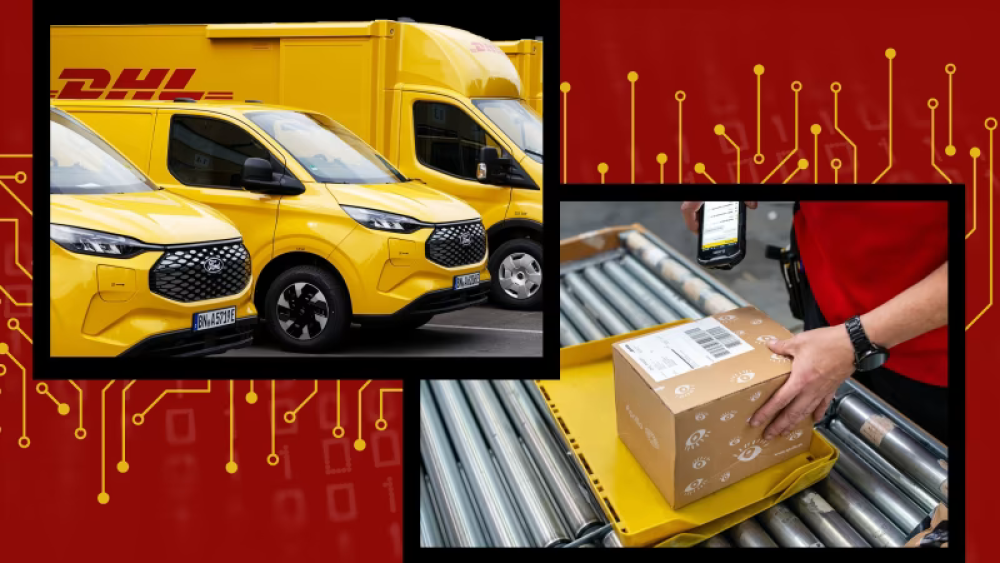
DHL Đức đang triển khai AI trên diện rộng để đối phó với tình trạng thiếu hụt lao động
-
DHL đang mở rộng việc sử dụng AI trong mọi khâu vận hành – từ tổng đài hỗ trợ khách hàng, kho vận cho đến huấn luyện nhân viên – nhằm giải quyết tình trạng thiếu hụt nhân sự tại Đức.
-
Một lỗi nhỏ trong hệ thống AI giọng nói – không nhận diện được từ “Ja” (có) – cho thấy tầm quan trọng của việc phân tích hiệu quả thực tế khi triển khai AI.
-
Tập đoàn khẳng định: AI không lấy đi việc làm, mà lấp vào khoảng trống nhân sự, đặc biệt khi 1/3 nhân viên hành chính sẽ nghỉ hưu trong 5 năm tới.
-
Dù một số nhân viên văn phòng lo lắng về việc bị thay thế, AI hiện chủ yếu hỗ trợ xử lý các nhiệm vụ lặp đi lặp lại như kế toán, kiểm tra dữ liệu và trả lời cuộc gọi.
-
Từ năm 2020, số nhân viên toàn cầu trong bộ phận vận hành đã tăng 17%, cho thấy AI đang giúp mở rộng quy mô thay vì cắt giảm nhân lực.
-
DHL sử dụng AI để thu thập và bảo tồn kiến thức từ nhân viên sắp nghỉ hưu: công cụ AI phỏng vấn họ và cập nhật lại quy trình, bao gồm cả các ngoại lệ thực tế.
-
Nền tảng nội bộ mang tên Gaia là “sân chơi an toàn” để thử nghiệm AI tạo sinh, hỗ trợ mã hóa hải quan và nhiều tình huống kinh doanh khác.
-
Hệ thống AI thoại của DHL hiện đã xử lý 1 triệu cuộc gọi mỗi tháng, và giải quyết được 50% yêu cầu mà không cần nhân viên can thiệp.
-
Các nhân viên trung tâm cuộc gọi không bị sa thải, mà được tái đào tạo thành “nhà thiết kế hội thoại” hoặc “giám sát chất lượng AI”, nhằm nâng cao độ chính xác của công cụ.
-
Dù AI chưa xử lý tốt giọng địa phương hoặc phong cách nói khác biệt, đa phần nhân viên đánh giá giải pháp giúp giảm công việc lặp lại và cải thiện trải nghiệm khách hàng.
-
Quá trình triển khai AI ở DHL Đức diễn ra chậm do phải đàm phán với hội đồng nhân viên (works council), đảm bảo tuân thủ pháp luật và quyền riêng tư dữ liệu.
-
AI của DHL còn hỗ trợ dịch thuật theo thời gian thực trên máy quét cầm tay, giúp nhân viên từ nhiều quốc tịch hiểu hướng dẫn giao hàng của khách hàng.
📌 DHL Đức đang cho thấy cách triển khai AI một cách chiến lược, thực dụng và nhân văn: không sa thải nhân viên, mà tận dụng AI để giảm áp lực công việc, duy trì năng suất trong bối cảnh lực lượng lao động già hóa. Với nền tảng Gaia và AI thoại xử lý 1 triệu cuộc gọi/tháng, công ty tập trung vào giữ lại tri thức, đào tạo lại nhân sự và giải quyết lo ngại từ hội đồng nhân viên. AI ở đây không thay thế con người, mà như “một đồng nghiệp lớn tuổi hơn” hỗ trợ từng bước.
https://www.ft.com/content/ce09786f-2481-44fe-957c-f7bb0b43e284
Inside DHL’s AI upgrade: ‘Love it or hate it, you have to work with it’
The German delivery company says artificial intelligence is not taking jobs, but filling gaps in a stretched workforce
© FT montage/DHL/Imke Lass
Andrew Hill
Published9 minutes ago
When DHL upgraded its AI-powered voicebot last year, the post and parcels team in Germany checked the transcripts of its interactions and noticed a problem. The bot often failed to recognise the word “Ja” — German for Yes.
Spotting and ironing out such a fundamental glitch “was a telling example of how important it is [with artificial intelligence] to take the time and do the analysis of what’s working well and what’s working less well,” says Benjamin Hübner, who runs consumer customer services for the division.
The voicebot is one result of efforts by DHL to apply AI to some of the trickiest problems facing the logistics industry and German business. Its progress shows how companies are embedding the technology deep inside their processes.
Faced with an ageing workforce and a surge in ecommerce, the German business says AI will plug looming staff shortages rather than force lay-offs. But on the path to the future, the group, which owns Deutsche Post and recently announced cuts to its 187,000-strong German post and parcels division, has to navigate tight rules, mandatory consultations and the concerns of workers.
Speaking in January 2024, DHL management board member Nikola Hagleitner contrasted the generally positive attitude of managers with the worries of front-line teams staffing call centres or delivering mail. The first group was “talking about gen AI and what gen AI can do, and how fantastic the world will be. But I have a big group of people who fear that their jobs are going to be lost”.
Bernd Gemein, chief information officer for post and parcels, says the prospect of AI taking on more work is still “rather frightening for those who do repeat control, accounting or invoicing [jobs] or [handle repetitive] customer calls”.
Angela Schoellig, a professor of robotics and AI
Angela Schoellig, a professor of robotics and AI, says that rather than worrying about job losses, workers now have a ‘general perception that we may need [technology] to keep the health and the wealth of the country’ © Astrid Eckert/Technical University of Munich
But the fear is tempered by an awareness of how technology can address Germany’s pressing demographic challenge. DHL has already pushed automation and AI through its warehouse and transport operations, where, among other things, it helps sequence orders, make the most of shipment space and predict volumes. Since 2020, employment in that division globally has risen by 17 per cent. According to Angela Schoellig, professor of robotics and AI at the Technical University of Munich, when she talks about automation she is no longer asked whether robots will take people’s jobs. Instead, “there’s a shift in the general perception [to the idea that] we may need these [innovations] to keep the health and the wealth of the country”.
At DHL in Germany, one in three staff working in support operations will retire in the next five years, taking with them decades of institutional memory. “Everyone in Germany understands that if you don’t automate and use AI, you won’t be able to deal with the shrinking workforce,” says Gemein.
For those carrying parcels and letters, the fear of a robot takeover is offset by an understanding that AI “can’t walk through the suburbs and deliver parcels”, Gemein says. Technology is helping here, too. In its search for workers, the group already employs a vast range of nationalities in the German delivery service, and handheld scanners used by staff already translate customers’ messages about, say, where to leave parcels, into 20 languages.
As staff leave, AI is helping plug holes in the company’s knowledge base. Outgoing workers document procedures they follow and some attend an exit “interview” with an AI tool trained on DHL’s official manuals. “The AI asks ‘have I understood the process?’ and the person might say ‘that’s right, but there’s this exception’,” explains Gemein. The tool updates itself with the additional knowledge which can then be used to train new recruits. AI is also making training materials more engaging, with staff encouraged to create short videos to explain new processes or services.
DHL’s group head of corporate development Yin Zou
DHL’s group head of corporate development Yin Zou calls the group’s closed hub Gaia a ‘safe playground’ where staff can experiment with AI © DHL Group
DHL’s generative AI experiments are happening on a group-wide closed hub, called Gaia, set up four months after OpenAI released ChatGPT for public use in 2022. Group head of corporate development Yin Zou describes it as a “safe playground”. Rather than be wedded to one large language model (LLM), DHL encourages staff to test options and experiment with novel AI agents, such as an assistant to help master the complexities of cross-border customs coding.
Still, it took six months to win approval for guidelines about the use of AI and Gaia from the German operation’s works councils, elected by employees to represent their interests. One early concern was that colleagues might enter sensitive data into unfenced LLMs. But the speed AI is developing demands a new approach to such discussions, says Dirk Schneider, a 40-year veteran of DHL who now chairs the works council for DHL’s German headquarters. “It’s so much faster than the old IT tools”, which used to change every six to 12 months, he says. Workers’ representatives are now negotiating with managers for a deeper agreement on principles, to speed up adoption of tools and improve security.
Regulation also places limits on how far DHL can go to develop some AI tools in Germany. A conversational customer service voicebot could infringe German postal law if it were to go off-message, so the current version is programmed to respond strictly within the rules and hand over to a human if it cannot provide an answer. Even this model already handles 1mn calls a month and can settle half of all queries without human intervention. As the bot’s ability to “understand” inquiries improves, customers no longer have to repeat their delivery number several times. Following complaints about, say, broken delivery lockers, the latest version automatically sets up a technician’s visit rather than simply logging the defect.
A DHL worker uses AI
A DHL worker uses AI. Staff representatives are negotiating with managers for a deeper agreement on the principles of AI use, to speed up adoption of tools and improve security © DHL Group
One DHL customer service agent, who declined to be named, says the voice recognition software still struggles, “especially when it comes to [dealing with] dialects or very different speaking styles”. But they agree it has reduced repetitive tasks. Hübner says most users “are thrilled by how easily it works”, adding the bot frees employees up to “use their valuable human brain to solve the customer problem”.
In March, DHL announced plans to cut 8,000 jobs in its German post and parcel division this year, but the company says that was related to the challenging economic environment not directly to technology.
Gemein says the group has not laid off any contact centre staff in Germany, but nor does it have to replace as many of those who leave voluntarily or hire temporary workers to cover pre-Christmas peaks. Human customer service agents are retraining in jobs such as “conversation designers”, working out which problems can safely be handed to the voicebot. Those who supervise call centre teams now act as “quality assurers”, making sure mistakes made by the AI are corrected, not amplified at scale.
“There are questions [from staff] and a certain level of insecurity,” says Hübner. “But that changes [when] people see the benefits of it in their day to day work.”
One way in which the German group has sought to improve acceptance from sceptical employees is by encouraging them to think of AI “not as a superintelligent master, but as an older colleague”, Gemein says.
“I think it’s the future,” adds Schneider. “You can’t work without it. Whether you love it or hate it, you have to work with it. So make the best of it.”
Thảo luận
Follow Us
Tin phổ biến



